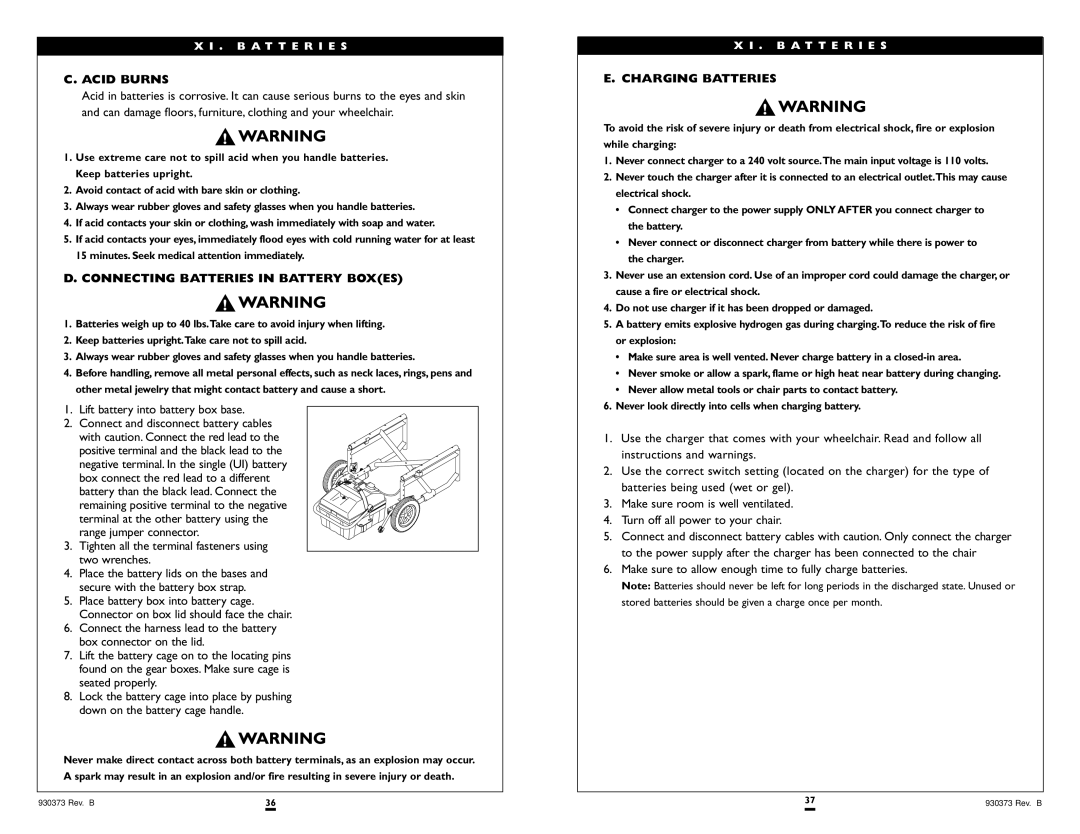
X I . B A T T E R I E S
C. ACID BURNS
Acid in batteries is corrosive. It can cause serious burns to the eyes and skin and can damage floors, furniture, clothing and your wheelchair.
1.Use extreme care not to spill acid when you handle batteries. Keep batteries upright.
2.Avoid contact of acid with bare skin or clothing.
3.Always wear rubber gloves and safety glasses when you handle batteries.
4.If acid contacts your skin or clothing, wash immediately with soap and water.
5.If acid contacts your eyes, immediately flood eyes with cold running water for at least 15 minutes. Seek medical attention immediately.
D. CONNECTING BATTERIES IN BATTERY BOX(ES)
1.Batteries weigh up to 40 lbs.Take care to avoid injury when lifting.
2.Keep batteries upright.Take care not to spill acid.
3.Always wear rubber gloves and safety glasses when you handle batteries.
4.Before handling, remove all metal personal effects, such as neck laces, rings, pens and other metal jewelry that might contact battery and cause a short.
1.Lift battery into battery box base.
2.Connect and disconnect battery cables with caution. Connect the red lead to the positive terminal and the black lead to the
negative terminal. In the single (UI) battery box connect the red lead to a different battery than the black lead. Connect the remaining positive terminal to the negative terminal at the other battery using the range jumper connector.
3.Tighten all the terminal fasteners using two wrenches.
4.Place the battery lids on the bases and secure with the battery box strap.
5.Place battery box into battery cage. Connector on box lid should face the chair.
6.Connect the harness lead to the battery box connector on the lid.
7.Lift the battery cage on to the locating pins found on the gear boxes. Make sure cage is seated properly.
8.Lock the battery cage into place by pushing down on the battery cage handle.
Never make direct contact across both battery terminals, as an explosion may occur. A spark may result in an explosion and/or fire resulting in severe injury or death.
X I . B A T T E R I E S
E. CHARGING BATTERIES
To avoid the risk of severe injury or death from electrical shock, fire or explosion while charging:
1.Never connect charger to a 240 volt source.The main input voltage is 110 volts.
2.Never touch the charger after it is connected to an electrical outlet.This may cause electrical shock.
•Connect charger to the power supply ONLY AFTER you connect charger to the battery.
•Never connect or disconnect charger from battery while there is power to the charger.
3.Never use an extension cord. Use of an improper cord could damage the charger, or cause a fire or electrical shock.
4.Do not use charger if it has been dropped or damaged.
5.A battery emits explosive hydrogen gas during charging.To reduce the risk of fire or explosion:
•Make sure area is well vented. Never charge battery in a
•Never smoke or allow a spark, flame or high heat near battery during changing.
•Never allow metal tools or chair parts to contact battery.
6.Never look directly into cells when charging battery.
1.Use the charger that comes with your wheelchair. Read and follow all instructions and warnings.
2.Use the correct switch setting (located on the charger) for the type of batteries being used (wet or gel).
3.Make sure room is well ventilated.
4.Turn off all power to your chair.
5.Connect and disconnect battery cables with caution. Only connect the charger to the power supply after the charger has been connected to the chair
6.Make sure to allow enough time to fully charge batteries.
Note: Batteries should never be left for long periods in the discharged state. Unused or stored batteries should be given a charge once per month.
930373 Rev. B | 36 | 37 | 930373 Rev. B |
